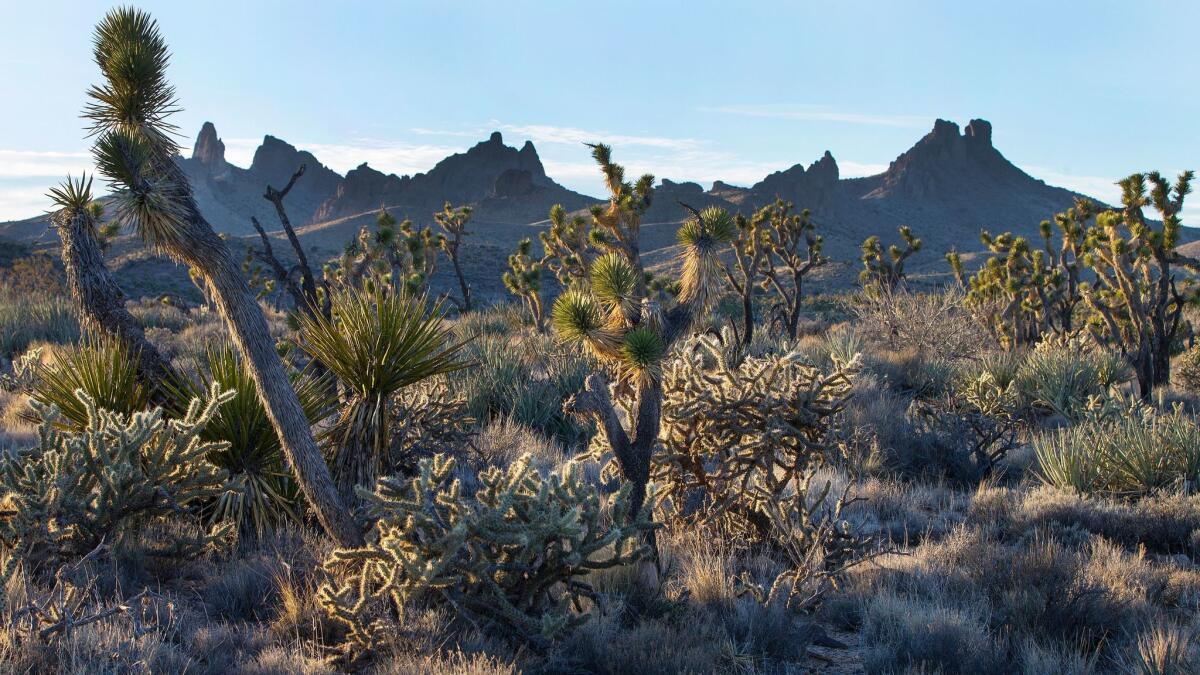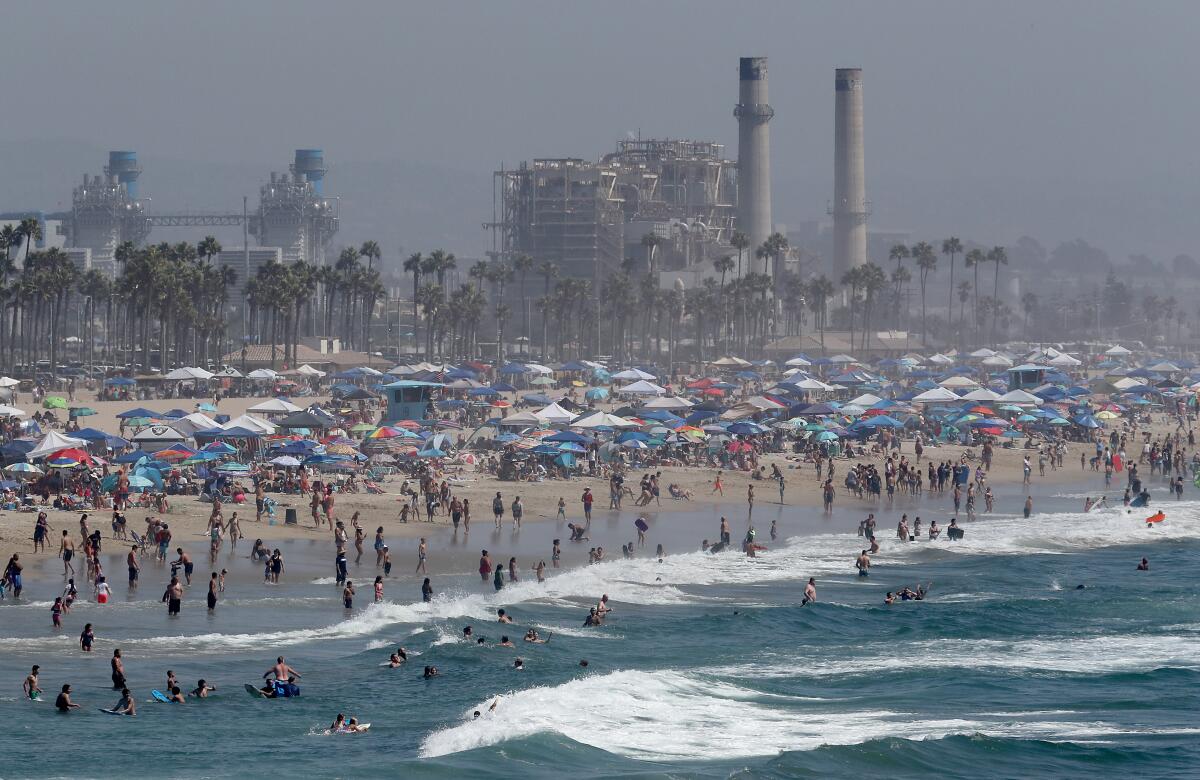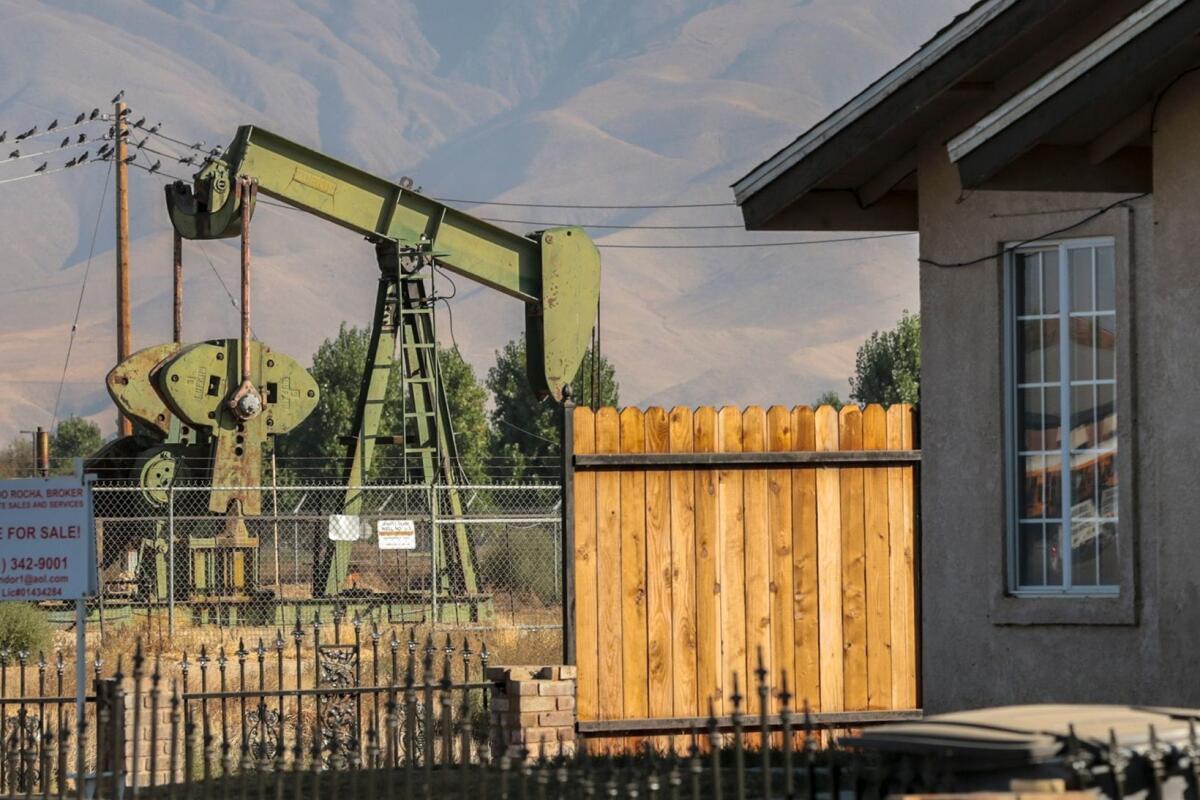As Biden takes office, it’s a whole new era for writing about climate change

- Share via
This is the Jan. 21, 2021, edition of Boiling Point, a weekly newsletter about climate change and the environment in California and the American West. Sign up here to get it in your inbox.
The last story I wrote before Donald Trump was elected president, four years and two months ago, was about the Obama administration’s claim that it had approved 60 renewable energy projects on public lands, capable of powering up to 5 million homes. I scrutinized those numbers, finding they dramatically overestimated the outgoing president’s accomplishments.
When Trump defeated Hillary Clinton a few days after the story published, I started to wonder if I had wasted my time.
As a journalist, I had focused my energies on holding President Obama accountable for not living up to his rhetoric on climate — and now he was being replaced by a man who denied the climate crisis even existed. Who would care that some of Obama’s solar and wind projects had never been built, when the federal government instead began promoting coal, oil and gas extraction?
With time, I realized that climate change is far bigger than any one presidential administration, and that my approach to covering it shouldn’t change with the political winds. I turned my focus to California, reporting on the state’s challenges and shortcomings in meeting its ambitious clean energy goals. I wrote about the natural gas industry’s efforts to block local climate policies. I explored the landscapes and politics of other western states, which are slowly shifting from fossil fuels toward renewables.
And now, with Joe Biden in office, there will once again be room for nuanced environmental reporting at the federal level. Journalists will be able to investigate whether the president and his appointees are matching their rhetoric with real action on climate and clean energy. We’ll be able to explore how the federal government might work with California to reduce emissions.
Toward a more sustainable California
Get Boiling Point, our newsletter exploring climate change, energy and the environment, and become part of the conversation — and the solution.
You may occasionally receive promotional content from the Los Angeles Times.
Suffice to say, I’m looking forward to the change of pace.
Naturally, my final story of the Trump era — which I reported before Biden’s inauguration, although it published today — harkens back to one of those nuanced Obama-era climate debates that I expect to be back in the spotlight over the next four years.
It’s a story about the Desert Renewable Energy Conservation Plan, a massive federal land-use plan known by the terrible acronym DRECP. Approved in the final months of the Obama administration, it seeks to strike a balance between the construction of solar and wind farms and the protection of wildlife and ecosystems across more than 10 million acres of California’s vast deserts.
I spent years writing about the DRECP for the Desert Sun, venturing out to remote spots in the desert — from Silurian Valley to Morongo Canyon to a cell tower along Interstate 40 — and familiarizing myself with many additional acronyms, from ACECs to SRMAs to LUPAs. When I thought it was all over, the Trump administration reopened the desert plan for possible changes.
I was surprised, but only a little bit, when Trump’s Interior Department finally announced its changes last week, proposing to remove protections from millions of acres and open vast areas to solar and wind farms. That was the subject of my story.
The changes came too late to be finalized, meaning Biden’s appointees could simply throw them out, if they want.
But here’s the nuance. Conservationists hate Trump’s 11th-hour proposal, and Biden pledged to protect 30% of America’s lands and waters by 2030. But renewable energy companies have argued that the original plan didn’t leave nearly enough space for solar panels and wind turbines in the California desert — and Biden also pledged to support a massive build-out of clean energy.
So maybe there’s a chance the new administration will go along with Trump’s plans for the California desert?
I’d say it’s unlikely; even if Biden’s appointees agree with solar and wind firms that more land should be opened to development, they’ll probably want to tweak the plan on their own terms, with an eye toward climate change and environmental justice.
But the fact that we’re even having this conversation is a breath of fresh air for anyone concerned about global warming, or about the loss of biodiverse landscapes that enrich human life. After four years of Trump, the key question is no longer how much environmental damage the U.S. government can do. It’s whether the U.S. government is living up to its promises or not.
And that’s a question I’m excited to start asking again.
For now, here’s what else is happening around the West:
TOP STORIES

The last seven years were the hottest seven years ever recorded. Here’s the story from my colleague Tony Barboza, who reports that 2020’s temperatures were either the highest ever measured or a close second to 2016, depending on whether you ask the scientists at NASA or NOAA. Either way, it’s getting too hot, too fast. Here’s some important analysis from the Atlantic’s Robinson Meyer, who notes that even after America’s planet-warming pollution fell by 10% last year amid the pandemic, we still need to slash emissions twice as much by 2030 as we did during the last 15 years to avoid the worst impacts of climate change.
Wildfire smoke now accounts for up to half of all fine-particle pollution in the West. Yet another scary story by Tony Barboza, about a new study finding that lung-damaging PM2.5 pollution from wildfire smoke doubled between 2006 and 2018 — and yes, that was before last year’s record fire season in California. Even in January, fire danger hasn’t abated. Southern California Edison shut off power to more than 78,000 customers this week to limit the risk of ignitions during dry, windy conditions, and Pacific Gas & Electric cut power to more than 30,000 as small fires burned, The Times’ Erin B. Logan and Susanne Rust report.
More than 1.6 million California households have been unable to pay their water bills at some point during the pandemic. A moratorium on water shutoffs has protected these Californians so far, but with $1 billion in unpaid bills across the state, public water districts are getting worried about their finances, as the San Francisco Chronicle’s Kurtis Alexander reports. Circle of Blue’s Brett Walton notes that Joe Biden’s COVID-19 relief plan includes $5 billion to help people pay overdue water and energy bills.
EXIT TRUMP, ENTER BIDEN
The Trump administration went out with a flourish, dropping a bunch of last-minute climate and energy decisions that would help industry but potentially hurt the environment in California and the West (if they’re not overturned by President Biden). Here’s a quick rundown:
- The Department of Transportation proposed to keep the penalties paid by car companies for violating fuel efficiency standards artificially low, and the Environmental Protection Agency proposed to exempt oil and gas producers from clean air regulations (story by L.A. Times columnist Michael Hiltzik);
- The U.S. Fish and Wildlife Service opened 3 million acres in the Pacific Northwest to timber harvesting, by removing land from the protected habitat of the northern spotted owl (Lisa Friedman and Catrin Einhorn, New York Times);
- The Interior and Commerce departments issued a rule that would allow for logging or road-building projects on federal lands even if those projects threaten endangered species (Martín Macias Jr., Courthouse News)
- The Bureau of Land Management stood by a plan that would benefit oil and gas drillers by relaxing protections for sage grouse in western states (Matthew Brown, Associated Press);
- The bureau also issued the first-ever oil and gas leases in the Arctic National Wildlife Refuge (Becky Bohrer, Associated Press).
Biden has already started undoing Trump’s climate legacy. Within a few hours of his inauguration, the president signed executive orders rejoining the Paris climate accord and canceling the Keystone XL pipeline’s federal permit, among other steps. More details next week; for now, read this story by my colleague Evan Halper about the president’s plans for a flood of immediate climate actions. On climate and other policy issues, Biden’s agenda is basically to Make America California Again, Evan writes. Biden also got an early assist from a federal appeals court, which struck down Trump’s plan to ease regulation of power-plant pollution.
It’s hard to know what comes next, but at least two political realities are clear. The first is that a majority of voters say climate change should be a priority for the president and Congress, according to the latest polling, with an overwhelming majority saying clean energy should be a priority, as John Schwartz reports for the New York Times. The second is that Joe Manchin, the Senate’s most conservative Democrat, will hold an enormous amount of sway. He’s still a fan of fossil fuels, but as James Bruggers reports for Inside Climate News, he’s not the same guy who literally shot a hole in the cap-and-trade bill a decade ago.
THE ENERGY TRANSITION

Another political reality is that fossil fuel companies will push back hard against aggressive climate policy. Nicholas Kusnetz wrote for Inside Climate News about the American Petroleum Institute’s plan to lobby for continued federal support for oil and gas. (His story includes the surprising fact the National Newspaper Publishers Assn., a Black press organization, has taken at least $100,000 from API; the press organization’s president said the oil and gas trade group could “count us as your partner.”)
Even in the absence of aggressive climate policy, it’s full steam ahead for renewable energy companies. One of the largest wind farms in the United States is now under construction in New Mexico; the California cities of Los Angeles and San Jose have agreed to buy some of the power, as Kevin Robinson-Avila reports for the Albuquerque Journal. Solar developers, meanwhile, are pleased that Congress extended a key investment tax credit last month, per the San Diego Union-Tribune’s Rob Nikolewski.
The Federal Energy Regulatory Commission upheld a decision by Oregon officials to block a natural gas export terminal. Here’s the story from the AP’s Gillian Flaccus. I wrote a bit about the proposed Jordan Cove facility last year, as part of this story examining efforts by fossil fuel companies to reframe the climate debate by casting themselves as allies of communities of color.
AROUND THE WEST
A decade ago, there was a big vision to fight climate change in Cascadia — Oregon, Washington and British Columbia. But emissions have actually risen in recent years, as Peter Fairley reports in this excellent deep dive for Investigate West. While the reasons vary across the U.S. states and Canadian province, the overarching problem is a shortage of political will, Fairley writes.
Five cities and Los Angeles County have decided the L.A. County Arboretum and Botanic Garden is the most “efficient” location for groundwater treatment ponds, and they want to cut down many trees and disturb the popular site to build them. If that sounds a little strange to you, well, all I can say is check out this story by The Times’ Louis Sahagún for the details.
“During the peak of a pandemic, why is an off-roading festival that will likely draw thousands to the desert being held?” That’s the question posed by my colleague Julia Wick in this story on the King of the Hammers event north of Joshua Tree National Park, which is described as part Burning Man and part “Mad Max.” State, local and federal agencies are all providing operational support. (By the way, if you don’t get Julia’s Essential California daily newsletter, it’s a great read and worth signing up for.)
ONE MORE THING
I was stunned and saddened to learn that Kevin Kelley, a longtime general manager of the Imperial Irrigation District and one of the most fascinating people I’ve ever written about, died suddenly this week at age 61.
Kevin was a masterful politician, a key player on the Colorado River and a warrior for the Salton Sea. He fiercely defended the Imperial Valley’s water rights from threats external and internal, and he wasn’t above backroom scheming, or blunt threats. Even when I wrote stories that didn’t paint him in a positive light, he was always willing to get on the phone — or, on one occasion, drive two hours from El Centro to the Desert Sun’s Palm Springs newsroom — and answer whatever questions I asked him.
The last time we talked was in April, as I reported a story on Imperial Valley politics. He had retired from IID, and he was eager to share insights and observations that he might previously have held back. “Don’t I sound liberated to you?” he asked me.
Here’s an obituary from the Calexico Chronicle’s Richard Montenegro Brown, which explores Kevin’s previous career in journalism and his talent as an improvisational pianist, and notes that he had nearly finished writing a book on Imperial Valley’s water history. Former Imperial County supervisor Wally Leimgruber tells me that he and a few other people plan to make sure the book gets published.
And here’s a news item that I’m sure gave Kevin some joy: After years of broken promises and false starts at the Salton Sea, the Desert Sun’s Mark Olalde reports, construction has finally begun on the ailing lake’s first large-scale restoration project.
We’ll be back in your inbox next week. If you enjoyed this newsletter, please consider forwarding it to your friends and colleagues.




